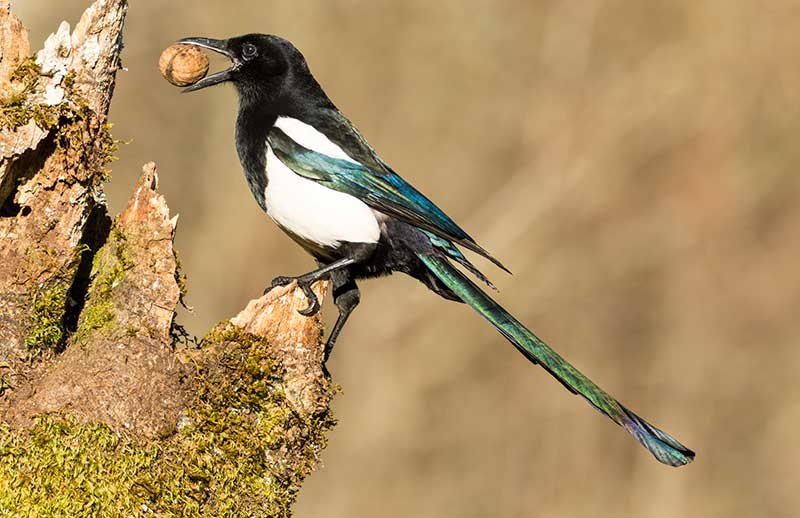
We’d both noticed that there seemed to be more of them, now that the cold weather has arrived and the last of the leaves have fallen. Always in pairs, they perch like snipers on the higher branches of the large, ailing cherry tree at the bottom of the garden. Often they land on the kitchen roof to strut, and gnaw at the sedum and other plants growing there. And when they swoop on the bird-feeders, they scatter the tits, sparrows, goldfinches and other smaller birds, until they themselves are dislodged by a movement inside the house.
It’s hard to say whether magpies really are more numerous (they feature as ‘green’ on the Red List of endangered birds). In winter their police uniforms stand out, while smaller birds tend to prefer the cover of what vegetation remains. Maybe it’s just that in winter they behave in an even more thuggish and insolent way than usual, flashing their Op Art wings and long black tail feathers, as if they were aristocrats arriving at a nineteenth-century opera. Their ‘krakakak’ alarm call sounds savage and mobsterish to most ears.

Needless to say, all this anthropomorphising does magpies an injustice. Don’t they deserve to be admired, rather than mocked or feared, if for nothing else than their faithfulness and intelligence?
Magpies mate for life, and are almost always seen in pairs, to such an extent that a single magpie is said to bring bad luck. The rhyme about them varies. This version dates from in 1777:
One for sorrow,
Two for mirth,
Three for a funeral,
Four for a birth.
A later version adds three more lines, but loses the distinction between odd and even numbers, imposing a negative view of the bird:
Five for heaven,
Six for hell,
Seven for the devil, his own self.
A more common modern version takes the tally to ten, and again names Satan, the label that the poor magpie so often attracts:

One for sorrow,
Two for joy,
Three for a girl,
Four for a boy,
Five for silver,
Six for gold,
Seven for a secret never to be told.
Eight for a wish,
Nine for a kiss,
Ten a surprise you should be careful not to miss.
Eleven for health,
Twelve for wealth,
Thirteen beware it’s the devil himself.
It’s said that of all corvids, even of all birds, Pica pica is the cleverest. A magpie can recognise itself in a mirror, a rare accomplishment among animals. It’s expert at imitating sounds. The poet John Clare noted that
it imitated many words readily and when it heard a sound or word that it could not imitate readily it would become silent and pensive and sit ruminating on an eldern tree and muttering as it were to itself som inaudible sounds till at length it got by heart the thing it was arriving at and then it was as lively and as full of chatter as ever.

But even the intelligence of magpies tends to be turned against them. Their reputation for being attracted to shiny objects may or may not be deserved, but the theory seems to lead inevitably to accusations of thievery, as in Rossini’s opera La gazza ladra.
Christians added their own negative myths. The magpie, some said, was the only one of the birds who failed to mourn Christ’s death on the cross. Another story had it that the magpie was the only bird not to enter Noah’s ark, ‘preferring to sit outside chattering and swearing in the pouring rain’. Superstitions proliferated, many intended to ward off the evil that the magpie embodied. If you saw one, it was wise to lift your hat, or address it with polite words, like ‘Good morning captain’ or ‘Good morning, Mr Magpie, how is your lady wife today?’

It doesn’t help that the magpie is an indiscriminate eater and will take the eggs and nestlings of other birds. (Though a study for the RSPB found it innocent of causing the decline in songbird populations, which is down to human interference – intensive farming and destruction of habitat – rather than predator bird behaviour.)
But if we filter out all the various historical prejudices against them – not shared, by the way, by Newcastle football supporters or by east Asian cultures (the magpie is the Korean national bird) – we’re left with just one unavoidable anxiety. That magpies are too ubiquitous, too omnivorous, too numerous and too successful. In this, of course, they resemble humans. Do we fear magpies, I wonder, because we fear our shared ability to scavage, bully and predate, to dominate and destroy other fellow-creatures?


Leave a Reply